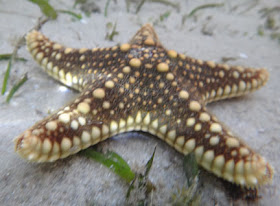We started well before dawn and were rewarded with a glorious sunrise!
Here's the glorious sunrise in its early stages, with the city skyline, a huge container ship and the container terminals. Cyrene lies in the middle of the industrial triangle and yet it has amazing marine life!
While it's still dark, we spot all kinds of animals that tend to hide during the day. How nice to see a Grey bonnet snail (Phalium glaucum) ambling about on the shore. This snail feeds on sand dollars, and is rarely seen elsewhere though common on Cyrene. Later on, we also spot the Japanese bonnet snail (Semicassia bisulcatum).
We stopped for a while on a seagrassy patch while we waited for the rest of the team to catch up and we spotted a small heart urchin (Lovenia sp.), lots of little Swimming anemones (Boloceroides mcmurrichi) and other small critters. The area is also dotted with Chocolate sponges (Spheciospongia cf. vagabunda) and Fan shell clams (Family Pinnidae). Also of course, lots of seagrasses and various kinds of seaweeds.
Wow, a nice large Snaky sea anemone (Macrodactyla doreensis)! Not very common elsewhere, but quite regularly encountered on Cyrene. Among the other anemone-like critters spotted by the team were zoanthids or colonial anemones (Order Zoanthidea) which contain palytoxin which is among the most potent natural marine toxins; Cerianthids (Order Ceriantharia), also called Peacock anemones because of their colourful variety, and the shy Wiggly star anemone (which remains unidentified though it is quite common).
We are thrilled with the sight of lots and lots of Knobbly sea stars (Protoreaster nodosus). Not just large adults but also some tiny babies. Joanne found one that was very well camouflaged among the seagrasses. According to the Star Trackers, "the presence of juveniles, subadults and adults indicated that there is a healthy level of recruitment at Cyrene Reef. This habitat may be the only sustainable population of knobbly seastars left in Singapore today". Among the Knobblies was the special Pentaceraster sea star (Pentaceraster mammilatus) that was first seen on Cyrene and is a new record for Singapore.
Cyrene has nice long sand bars which are teeming with Cake sand dollars (Arachnoides placenta). Also many Common sea stars (Archaster typicus), including a pair in mating position! The higher portions of the sand bar are dotted with signs of Sand bubbler crabs (Scopimera sp.). Not to forget the intriguing sand coils made by Acorn worms (Class Enteropneusta). The presence of such marine life shows that the sand is clean.
Another curious creature that is abundant on Cyrene are White sea urchins (Salmacis sp) that carry things. So they are rather hard to spot. This sea urchin is more common on our northern shores like Chek Jawa and seldom seen on our southern shores. Indeed, I consider Cyrene the Chek Jawa of the South.
The team spotted a Fan seaweed (Avrainvillea sp.) with tiny Strawberry slugs (Costasiella sp.) on it. I couldn't take a photo of the slugs with feeble Swimming Camera so here's an old photo I took of the slugs.
Fortunately, we had time to make a quick stop at the reefier parts of Cyrene to check out some of the huge corals that are found here. The team spotted a Marine spider (Desis martensi) crawling on the corals!
And many sponges, flowery soft corals (Family Nephtheidae) and other reef animals.
There are also lots of leathery soft corals (Family Alcyoniidae), rather smaller than usual following the mass coral bleaching event in 2010.
Here's a healthy brown Cauliflower coral (Pocillopora sp.). These were among the first to bleach during the mass coral bleaching event in 2010.
Fortunately, most of the corals were healthy, although we did see one that was partially bleaching. Let's hope our reefs will be spared global mass coral bleaching this year!
The sharp-eyed team spotted lots of other animals that I didn't photograph, including: a cute hairy crab (Family Pilumnidae) that looks fluffy so we sometimes call it the 'Teddybear crab', a pair of Flower crabs (Portunus pelagicus) mating, lots of hermit crabs large and small. Resembling tiny lobsters, we saw and heard snapping shrimps (Family Alpheidae). We saw several scary bristleworms (Class Polychaeta), nice feathery fanworms (Family Sabellidae).
As we were leaving CE MPA stopped by to chat with Siti who was on Cyrene for her seagrass experiment. She shared more about her work and the seagrasses on Cyrene as well as elsewhere in Singapore.
Today, a large team was with Siti to remove the experiment as it has come to an end. So the sandy bit is busy with lots of people as the tide turns and it's time to leave Cyrene.
On the way home, CE MPA pointed out this enormous blue container ship which is among the largest container ships in the world. I take a closer look and wow, it is indeed about twice as large as the other ships. Despite the world class industrial and shipping activities that go on in our waters, Singapore still has awesome marine life!
Thanks to Joanne for organising this trip which arose from the little talk I gave to MPA last month. And a big thank you to CE MPA and all the MPA staff who made time to come, and put up with my lame jokes and spotted so many great things on our trip!
Joanne Fang shares some wonderful photos of our trip on facebook.
Here's some posts and photos shared of Cyrene by volunteers who were on the shore together with Siti. I'm so sorry I didn't have time to take better photos today.
- Rick on facebook
More about Cyrene Reef.
















